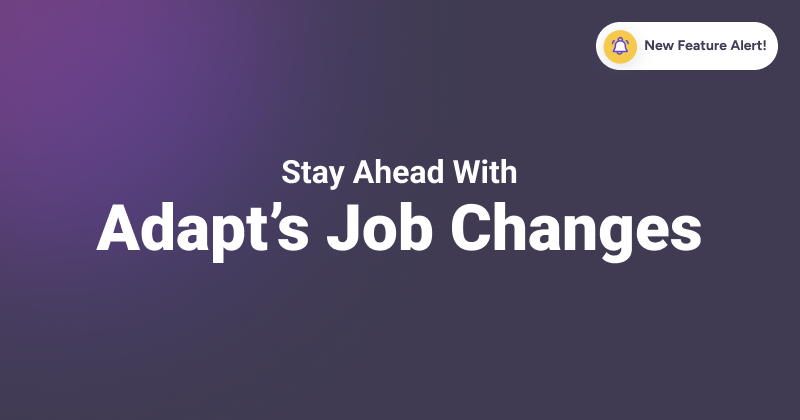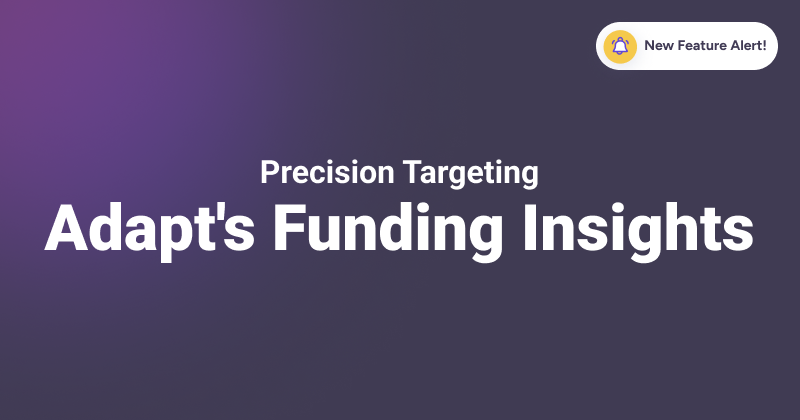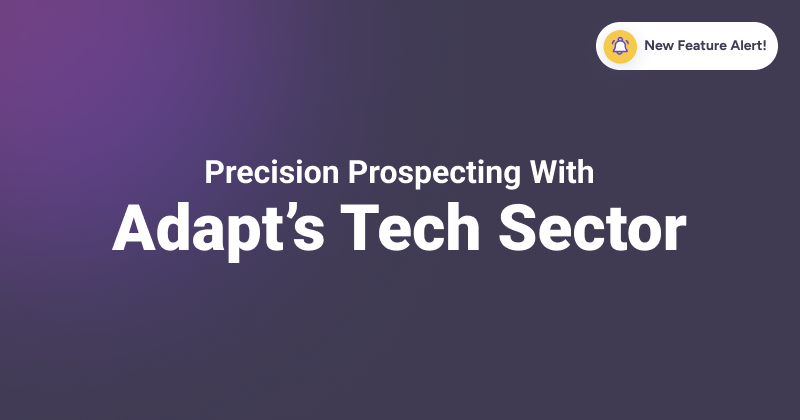A sales rep’s primary goal is to exceed their targets- but this year, it has taken a lot more work than before.
In the digital world, buyers have unlimited access to information and typically spend less time talking to vendors. A recent Gartner report says that B2B buyers considering a purchase spent only 17% of their time meeting potential suppliers. The amount of time spent talking to sales professionals is only 5-6%.
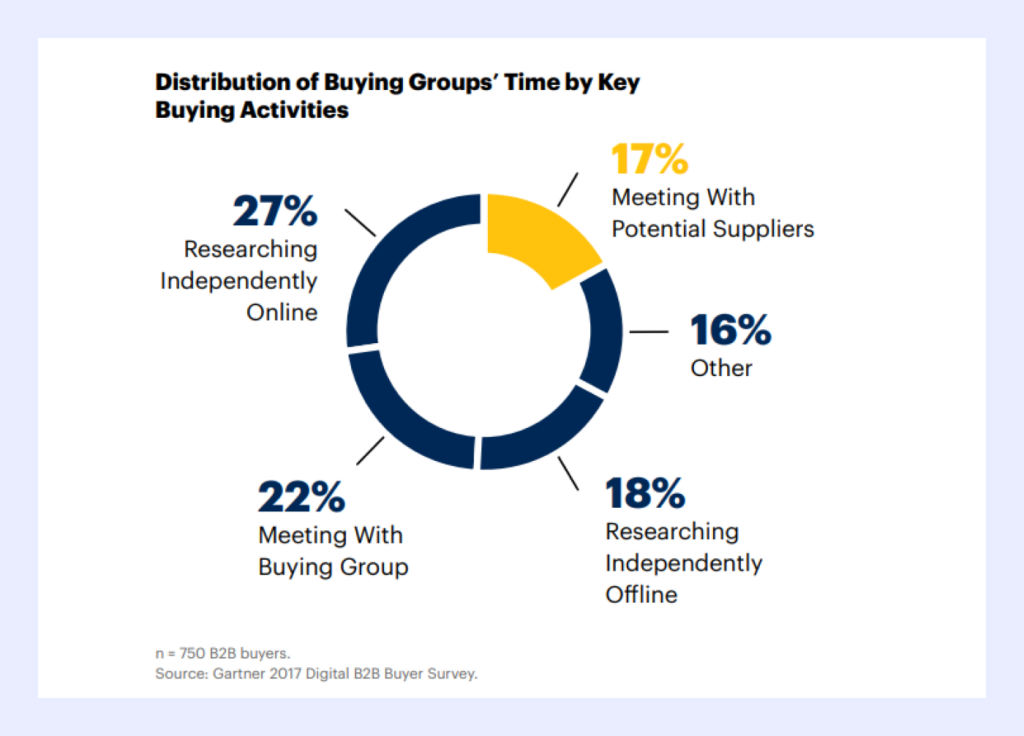
The hardest part of B2B selling isn’t selling anymore but becoming accessible to B2B buying groups. Sales leaders should now evaluate their prospecting methods to meet the modern B2B buying journey.
This blog will detail various prospecting methods, define your ideal buyer, give tips to improve sales prospecting and explore ways to connect with prospective clients.
B2B Sales prospecting vs lead generation
B2B sales prospecting and lead generation are often used interchangeably but are distinct components of the sales and marketing process. Each plays a specific role in identifying, nurturing, and converting customers in a B2B scenario.
Before diving into the practical stuff, let’s quickly understand what B2B sales prospecting is and how it differs from lead generation and demand capturing.
What is B2B sales prospecting?
B2B prospecting comes in the earlier stage of the B2B sales process. It is the process of identifying and qualifying potential customers looking for your product. It aims to build a targeted list of potential customers through extensive outreach.
What is lead generation?
The terms “lead” and “prospects” are often confused as synonyms but are quite distinct.
Lead generation starts with prospecting. These are supposed to generate sales opportunities even from companies that are not actively buying. Lead generation can be done through paid ads, gated content, or webinars.
In simpler terms, you reach out to people in prospecting, but in lead generation, people reach out to you.
Define your ideal Customer Profile (ICP)
It’s a familiar saying in the business world that 80% of revenue comes from 20% of customers.
Ideal Customer Profile or ICP contains a list of attributes that your best customers have in common. By creating a set of criteria to look from, you can save valuable time that would otherwise be wasted on unqualified prospects.
Select the best 10 customers to analyze their buying process and why they choose your product/ service. Sit with your sales team and ask these questions:
- What goals they were trying to achieve?
- What factors influenced their buying decisions?
- What concerns/objections did you face during the sales call?
- What were the benefits they got after buying your product/service?
- What features/services did they mostly use or ask for?
You can also run in-depth customer reviews to understand their problems, objectives, and goals in detail.
At the end of this process, you will be able to define your ICPs:
- Buying triggers- What leads to start looking for a product like yours?
- Research process- Where and how did they reach you? What information were they looking for?
- Decision-making process- What influences their buying decisions? Who is involved in the product approval process?
- The value they got from the product
- Goals, needs, and challenges
- Where do they get industry information from? Who do they follow?
As sales professionals, you can now clearly paint a picture of who you are looking for, their buying habits, and where they are present. The more information you have, the better it is.
Calculate your TAM, SAM, and SOM for prospecting
Besides determining your ICP, you also need to calculate your Total Addressable Market (TAM), Serviceable Available Market (SAM), and Serviceable Obtainable Market (SOM) to-
- Determine if there are enough prospects to generate demand that brings in revenue.
- Target specific segments that are realistically reachable and may have a higher potential for success
- Guide businesses in allocating resources to the specific market share
- Assist in tailoring marketing strategies to target specific segments and capture a realistic market share.
Total Addressable Market (TAM)
TAM refers to the maximum revenue potential or total demand of a product or service. This helps sales professionals determine how many customers they can reach with their marketing and sales channels.
The easiest way to calculate TAM is through the bottom-up method. It is based on previous sales and pricing data.
First, multiply your average sales price by your number of current customers. This is your Annual Contract Value or ACV. Now, multiply your ACV by the total number of customers. This is your total addressable market or TAM.
Let's understand this through an example-
For instance, you sell accounting software in Boston. Your average sales price is $1000, and your current customers are 500. So, your total ACV (Annual Contract Value) is $500,000. Now, multiply this number by the total no. of companies in Boston; say it’s 200. So, your TAM for your accounting software is $100 million.
Serviceable Available Market (SAM)
You can further narrow your TAM into SAM (Serviceable Addressable Market).
SAM is the proportion of TAM that actually needs your product/service. Given their customer profile and the company’s offerings, it gives a realistic overview of the number of people who can someday become your customers.
Serviceable available market (SAM) = Targeted segment TAM X ACV
Taking the example from before, if only 100 people in Boston can afford your accounting software and your ACV is $500,000, your SAM will be $5 million.
Serviceable Obtainable Market (SOM)
SAM calculates the current market share of the company in proportion to SAM. This is important to consider when you are expanding operations. SAM refers to the portion of the total addressable market that a company can realistically serve, while SON is often used to describe the portion of the SAM that a company can capture.
Serviceable Obtainable Market (SOM)= Market share of previous year X SAM for this year
Now, If your SAM of last year was $4 million and you made a revenue of $400,000, then your market share is 0.1. Thus, the SOM would be 0.1 X $5 million (this year SAM), equal to $500,000
Ways to improve your B2B sales prospecting process
1. Create compelling content
According to Seismic, 95% of B2B buying decisions are influenced by content.
Content is an easy and effective way to inform, educate, and engage buyers towards your product/ solution. However, sales reps spend 40% of their time looking or creating enablement content to share with buyers.
That’s why you must be armed with high-quality sales and marketing content that sales pros can easily share with potential prospects.
You provide Customer Relationship Management (CRM) software that helps small real-estate companies scale their business. So, your ideal content stack should include-
- Relevant case studies on how you helped brokerage companies improve their sales.
- Guides on improving real-estate lead generation and sales
- Research reports on the benefits of using CRM for real estate
- Product videos to showcase its features
- Blog posts on client-specific queries
The marketing and sales teams should align to create easy-shareable content that has a coherent brand identity and messaging that paves the path for successful outreach.
2. Lead scoring
Every customer is different, nor they require the same effort. You need to implement lead scoring to identify the best of the best leads.
Lead scoring is a concept for determining the business value of a generated lead. It is displayed as scores based on predefined criteria on the likelihood of a lead to make a purchase.
When implemented correctly, lead scoring can help your company-
- Spend more time with highly potential customers
- Identify channels that bring you more qualified leads
- Assign resources based on how likely they are to convert
- Scale your business by organizing and managing leads efficiently
Calculate your lead scores
Here is the step-by-step method to run a successful lead scoring:
Step-1 Analyze your ICP to find out what your customers have in common and what made them convert.
Here is what your analysis may look like:
- Has a revenue of over $500,000 and employees between 20-50.
- Is a decision-maker
- Has clear challenges that align with business products or service
- Frequent website visits or social interaction
Step 2 Determine the scoring criteria for these characteristics. Here is a template for you-
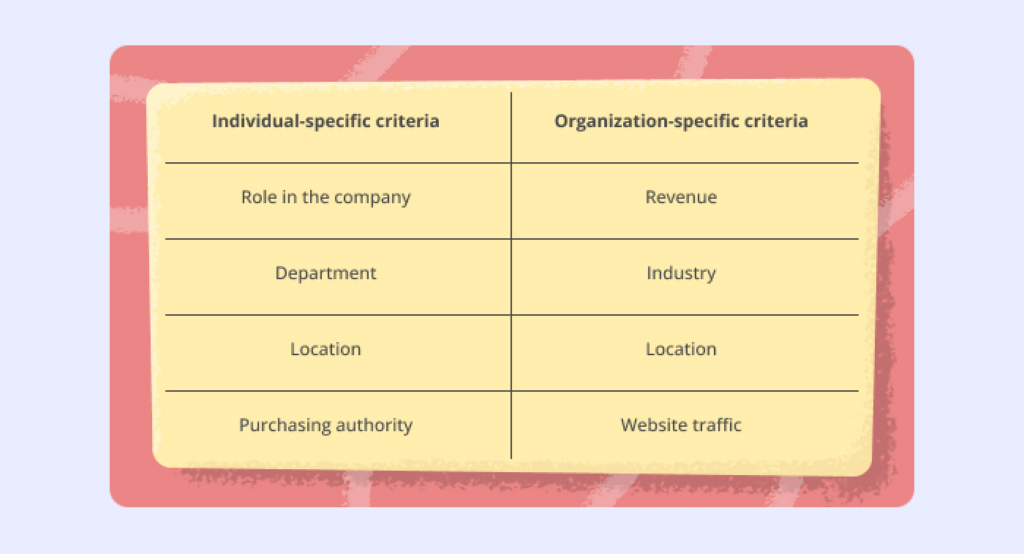
Step 3: Assign points to each activity based on their contribution to closing leads.
For instance, your chances of conversion are high with companies that are active on their website and social channels. So, the leads that don’t have a website or aren’t active would be scored lesser to them.
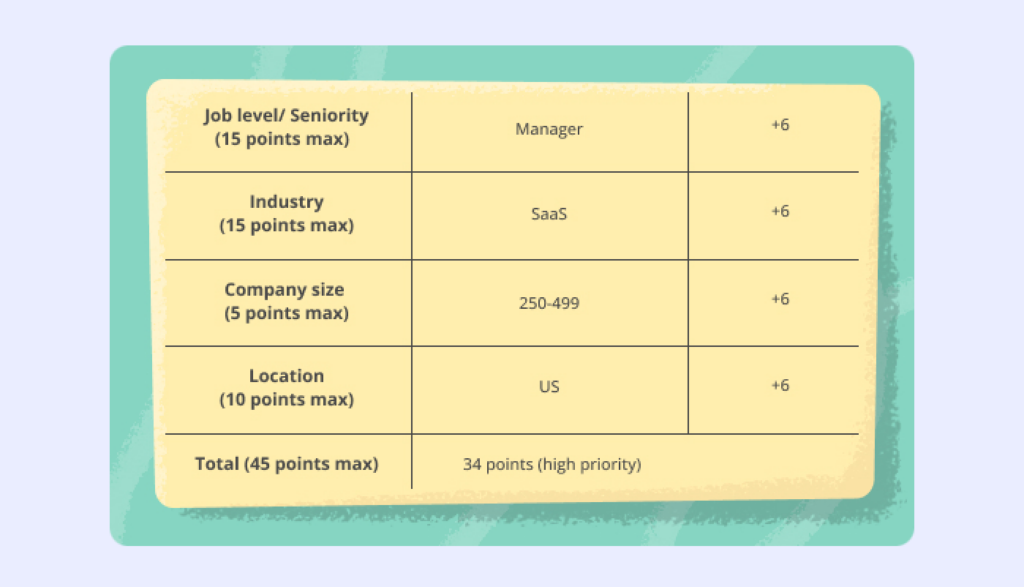
Step-4 Define a score range to evaluate whether a lead is qualified for sales. For instance:
- 30-50 points – high priority;
- 25-15 points – average priority;
- Less than 15 points – low priority.
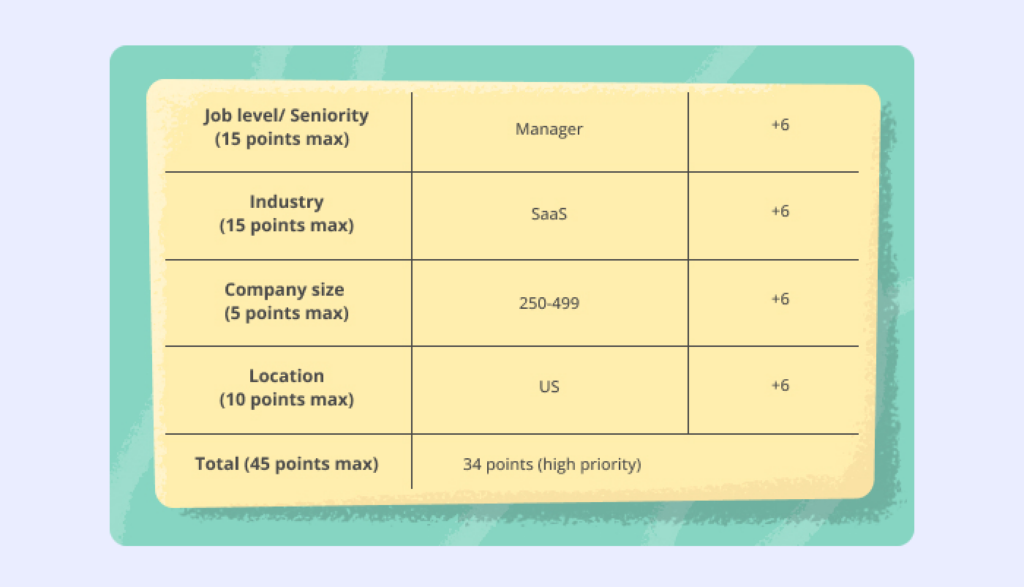
3. Research your potential customers
According to Hubspot, 82% of sales reps say building relationships is the most important part of selling.
Sales reps must identify potential connection points to show their customers they have taken the time to understand their needs. The first outreach should be brief and personalized, focusing on solving a specific problem by offering a particular solution.
Refer to the information and connection points uncovered in the research and tie them back in favor of your product or service.
Here is a checklist to research your potential customers-

Getting all the information might not be possible, but the more you find out, the better. You can quickly check their social account, company and media pages, and review sites to get most of the information.
The best outreach is the one that shows your business cares about your client and knows what exactly they are looking to solve. Instead of just selling to them, try building a connection through any of these points, and you are most likely to succeed.
5. Automate wherever possible
Over half (53%) of B2B teams still prospect manually. But, the biggest issue with manual prospecting is that it consumes a lot of time. When you employ great sales reps, you want them to spend most of their time pitching, proposing, and closing deals.
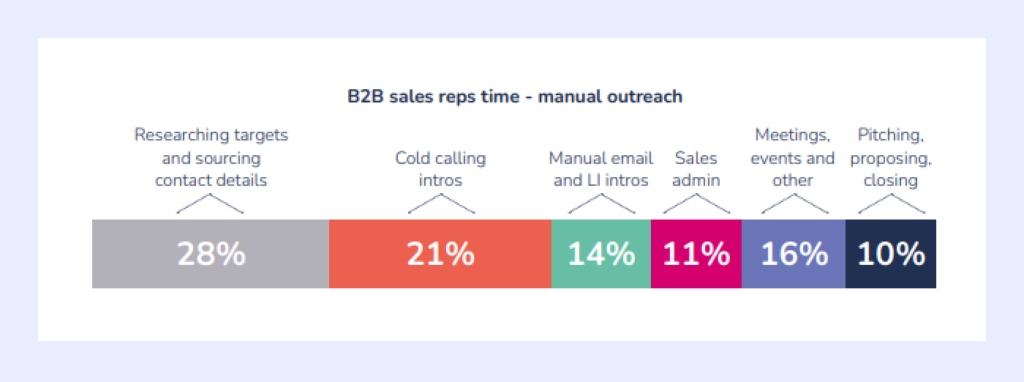
These are some tasks that you can easily automate in your B2B prospecting journey-
- Searching and finding B2B contact data using a reliable prospecting tool like Adapt.io
- You can easily do lead scoring through Active Campaign and Hubspot CRM.
- Track and organize your leads using an AI-enabled CRM
- Save hours creating content from scratch using Jasper.ai.
- Capitalized LinkedIn extensive user base through LinkedIn Sales Navigator.
- You can use a cold email outreach tool for email automation, scheduling and follow-ups.
- You can use sites like G2 and Capterra to research the prospect’s product, competitor, and challenges.
Implementing AI tools into the sales process brings numerous advantages, from minimizing the time spent on manual tasks and gaining a deeper understanding of customers to enhancing personalization and overall efficiency.
How to source top-quality leads
In the B2B world, the quest for high-quality leads is an ongoing challenge. Fortunately, there are a number of sources where you can find valuable B2B leads. These are some top sources to find high-quality leads for your business-
1. Use a reliable B2B prospecting software
A reliable B2B prospecting software is a tool designed to help businesses search and find potential buyers for effective outreach efforts. The primary goal is to streamline the lead generation process and improve the efficiency of sales and marketing efforts.
Here, you can use Adapt.io to search your target audience in just a few clicks. Additionally it provides,
Access to 175M+ Contact Profiles: Get access to a vast database of over 175 million contact profiles. A substantial pool of potential leads and decision-makers across various industries globally, Adapt makes it easier to find the right set of leads.
Real-Time Verification: Real-time verification is a crucial feature in prospecting tools. It means that the contact information provided by Adapt is verified and up-to-date at the time of access. This helps users avoid reaching out to outdated or incorrect contact details, ensuring that their communication efforts are directed towards active and relevant prospects.
Technographic Data: Technographic data refers to information about the technology stack or tools used by a company. In this context, Adapt provides insights into the technological infrastructure of businesses.
Advanced Filters: Adapt offers advanced filtering options, allowing users to refine their searches based on specific criteria. This could include industry, company size, geographic location, and 20 other data parameters.
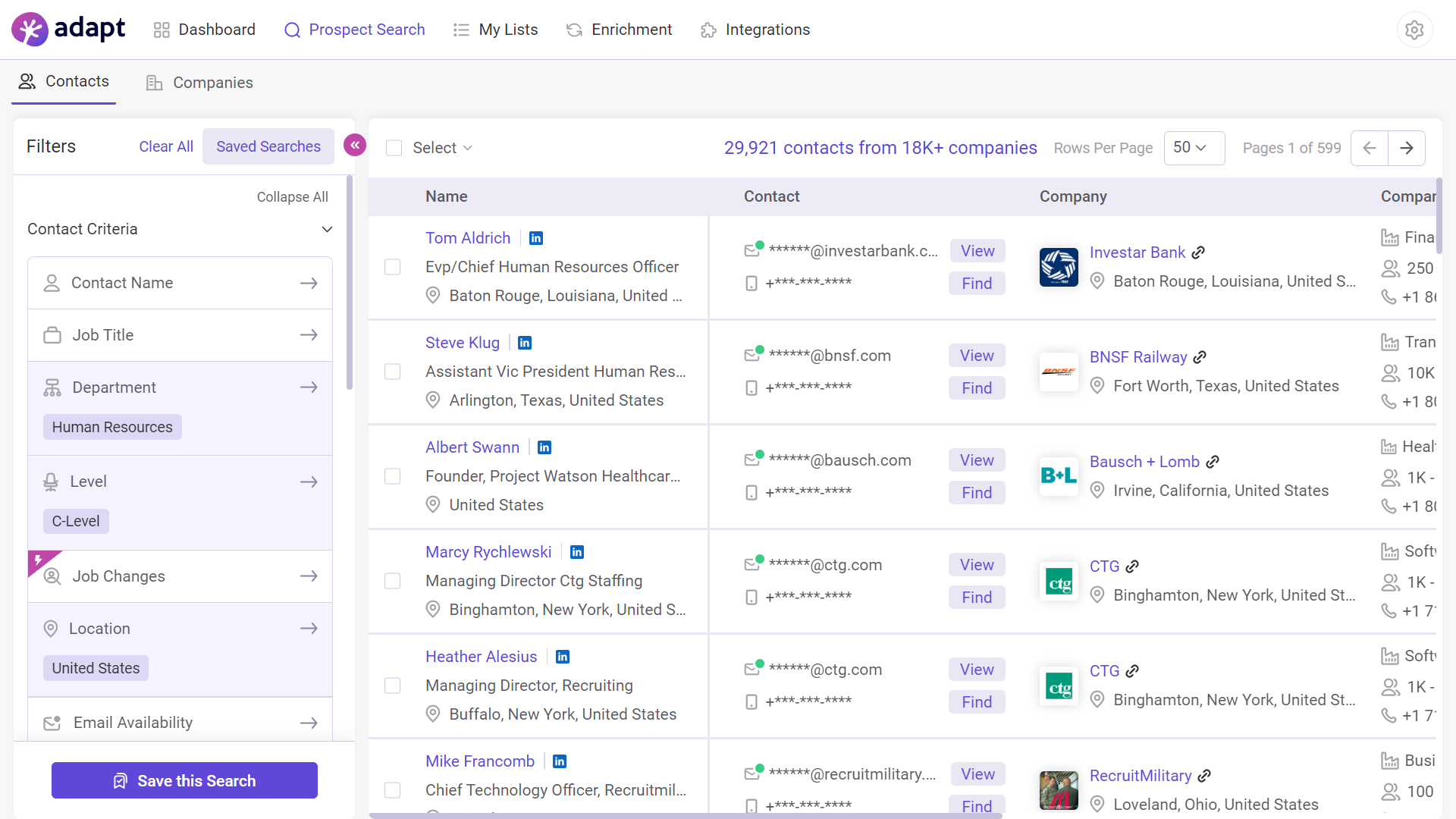
You will now get a list of B2B contacts with their email address and mobile and details about their company. You can easily add contacts to lists, export them as CSV, or to your CRM.
2. Use LinkedIn sales navigator to find leads
LinkedIn is an excellent source for finding good leads. It provides a ton of information to qualify leads, including their industry, company size, job title and location.
While a regular LinkedIn business profile will provide you with some information, it’s limited by your network. You can use LinkedIn’s Sales Navigator advanced filtering feature to find the people you seek.
Here is how to use Sales Navigator-
Step-1 Sign up for Sales Navigator
Step 2 Create your ICP through the filters to reach your potential clients.

Step- 3 Examine their profiles to identify some connections (like we discussed above)
Step-4 Use LinkedIn automation tools to send these people personalized connection requests. You can skip this step if you will eventually cold call or email them since connecting with everyone is impossible.
You can extract the leads from LinkedIn Sales Navigator and transfer them to your CRM or export them into an Excel sheet.
3. Use B2B directories
A B2B directory enables you to find leads at no additional cost. These directories rank companies for specific keywords, and you can easily find businesses that match your ICPs.
Here are the top B2B directories that can be used to reach ideal prospects:
- Yelp– has over 240 million reviews (the exact number of companies registered on Yelp is not explicitly mentioned anywhere)
- Clutch– has over 500,000 firms and agencies.
- SAP– has over 100,000 companies
- Capterra– has over 400+ categories listed on different types of software.
- G2- has over 100,000 software and service companies across 2000+ categories.
- Adapt– has over 175 million business contacts.
- Techsalerator– has over 320 million companies registered.
- Trustpilot– has over 714,000 websites
Ways to reach qualified B2B prospects
Only relying on a single channel isn’t enough when prospects are increasingly immune to traditional methods. Top-performing teams use multi-channel prospecting to communicate with potential customers on multiple platforms simultaneously. The goal is to reach leads on the platform they prefer and are most likely to respond to.
Here are the top ways to reach out to your potential leads-
1. Email Prospecting
Cold emails have gotten a bad rep, but it is the most reliable channel for driving leads. Research shows that 77% of B2B buyers want to hear from suppliers through cold emails. An email includes all the key information your prospect needs to decide if they need to offer or not.
However, the secret of creating a successful B2B email marketing strategy requires meticulous planning- clickbaity subject lines, spam messages, and one-size-fits-all-all messaging don’t work anymore.
Here are some interesting facts to consider when writing your next cold email –
- Your subject line should be short and punchy- three to seven words (character count around 40-60) usually has the best open rates.
- Your email body should be between 251-300 words. There are no specific rules, but shorter or shorter emails can affect your response rate.
- Always talk like a human; personalization is a key in cold emails. People love words like “partnerships”, “coffee”, “intro”, and “discussion” because it sounds like a collaboration, not a hard sell.
- The best time to send a prospecting email is 11 am on a Monday, and the worst is 3 pm on a Friday.
The best cold emails show hyper-personalized research, how they can solve a problem and focus on building a relationship, not only on selling. Always use efficient email marketing software (like Mailchimp or Sopro) to manage your prospecting efforts. These tools let you categorize leads, track interactions, and set follow-up reminders, ensuring you don’t miss opportunities.
2. Cold calling
Cold calling is not a dead practice- in fact, 57% of C-level buyers prefer to be contacted via phone. By hearing a prospect’s voice and understanding their reaction, sales reps can deliver a more human touch and build deeper connections.
But, successful cold calling is a skill that you need to master. This is how you can turn cold calls in your favor-
- Pre-call study- Take some time to understand your buyers, their businesses, and the challenges they are trying to solve. Look for potential connections from where you can build your conversation.
- Master your pitch- You only have a few seconds while cold calling, so you must have a script ready. Mention what your company does, what value you bring to customers, and why this product/service is best for them.
- Find a compelling opening statement- The easiest and simplest way of opening up and getting the prospect’s response is by saying their name and asking them how they are doing. It’s so simple that many do not believe it. Research by Gong says that “How have you been?” increases the success rate by 6.6 times.
- Ask open-ended questions- You don’t want a conversation to end with a “yes” or “no”. Asking open-ended questions breaks the ice and makes the prospect comfortable. This way, they are more likely to listen to you and keep the conversation interesting.
And that’s how you nail your cold calls. If you are looking for a complete guide on writing scripts for cold calling, you can visit here.
3. LinkedIn
Linkdln has the largest professional network on the internet. With the right outreach strategy, LinkedIn cold messages have a reply rate of 10-25%, which is higher than cold calls and emails.
Remember, if you want to send messages to people you are connected with directly, you must buy LinkedIn premium or purchase InMail credits.
The “Spray and Pray” technique of sending cold messages doesn’t work here, too. You will need to craft personalized messages to get their attention.
Here is a template for you-
Hey {First_Name},
I’m reaching out in regards to our (insert the name of your product/service)
I’m amazed at your accomplishment in (work achievement). You are definitely a leader in your field. Our tool is specifically designed to help industry leaders like you simplify your marketing process and reach your audience at the click of a button. We have helped XYZ in your industry generate leads worth $50k in just a month.
I’d love to contribute to this conversation over a virtual coffee. Are you up for it? Here’s my {{Calendly link}}, pick a time and a date.
LinkedIn also allows you to send sponsored in-mail messages to a targeted audience. It does not replace in-mail messages but allows you to send direct messages to a specific audience without connecting with them. Remember, no one can reply to this message, so your CTA needs to be clear on what you want a person to do next.
Here is what a sponsored message looks like-
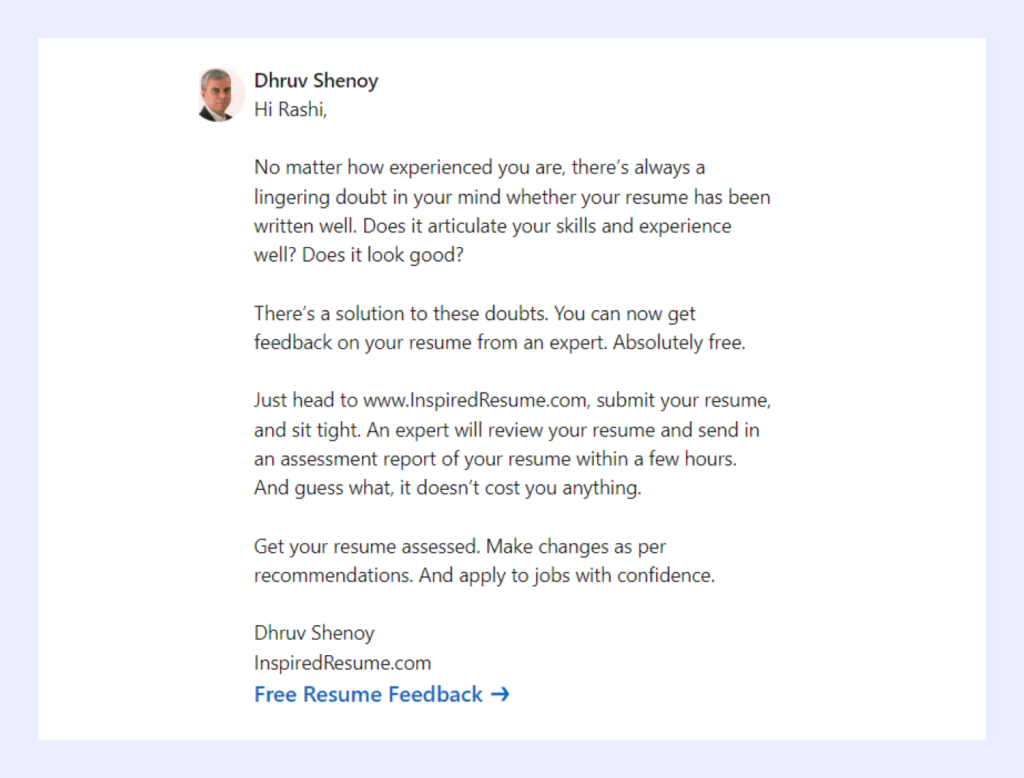
4. Twitter
Like LinkedIn, Twitter with 541 million monthly active users, is an excellent platform to reach your potential buyers. The platform’s advanced search feature lets you locate prospects interested in your products or services.
Here are some Twitter features for prospecting –
- Twitter lists- A Twitter list is a curated group of Twitter accounts created by a user according to specific categories. Lists can be public or private, and any Twitter user can create them for their use. You can search for keywords to find these lists and get connected with potential prospects.
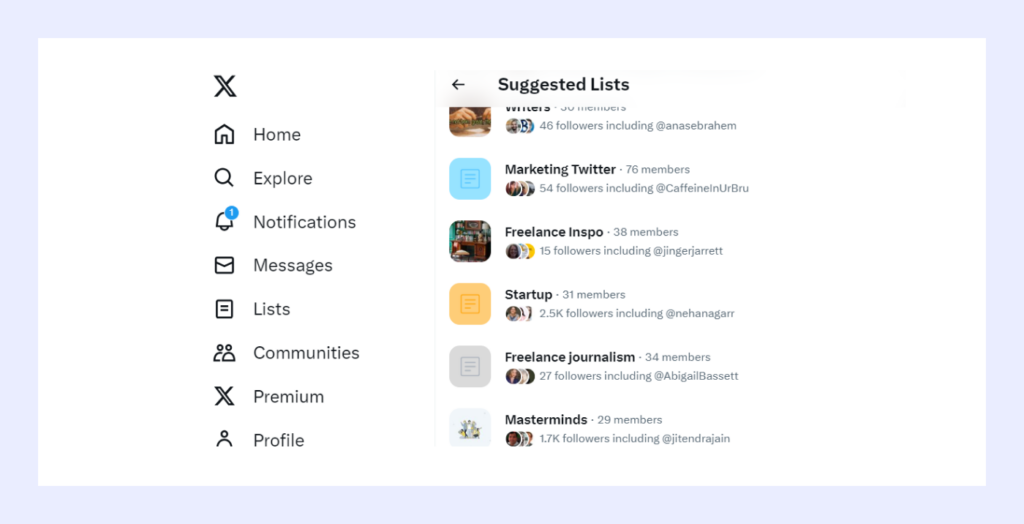
- Twitter Spaces- Twitter Spaces allows users to host and participate in live audio conversations. It’s similar to other audio-based social networking platforms and was designed to provide a space for real-time discussions and interactions. Sales reps can join relevant Twitter Spaces to provide value and find prospects benefiting from their product/ service.
- Twitter communities- Twitter communities provide a space for users to engage in discussions, share content, and connect with like-minded individuals. You can join relevant Twitter topics to interact and build relations with potential buyers.
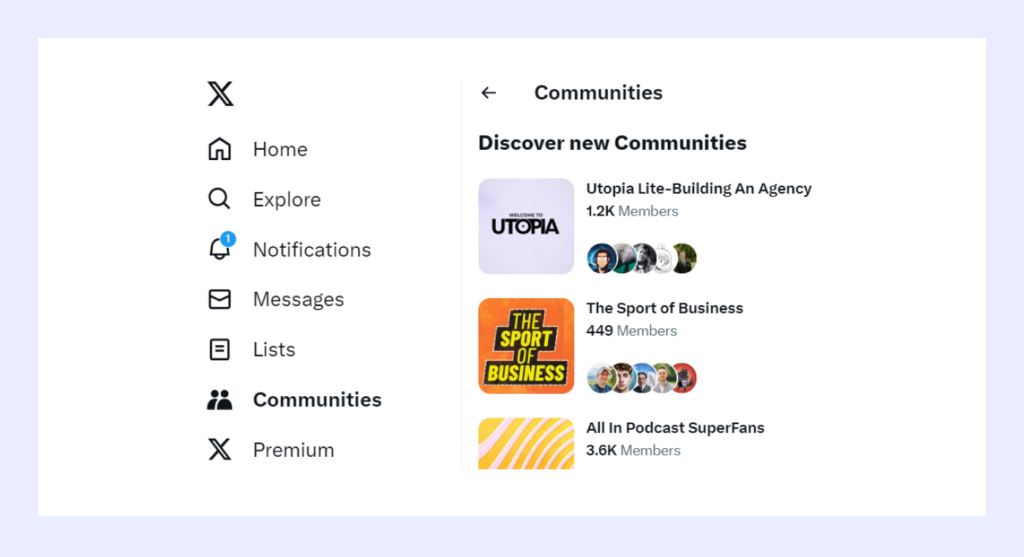
Next, create a list of prospects and start sending them personalized messages. Here is an example-
Hey (First Name)
I hope this message finds you well!
I noticed we’re both part of the [List Name] on Twitter, and I couldn’t resist reaching out to connect.
I’ve enjoyed the content you share on the list, especially [mention something specific you liked or found interesting]. If you’re up for it, I’d love to hear more about your experiences and perspectives on [ Mention the topic name]
Best,
[Your Name]
5. Customer referrals
Customer referrals are considered the most valued source of leads for any business. These people have already worked with you and would happily refer you to your services. Companies similar to your customers would likely have the same ICP and meet the criteria of solid prospects.
You can create a referral program where you offer incentives to those who refer leads that convert to customers. This can be in the form of cash rewards, discounts, or other valuable perks.
Here is an exact mail you can send to your existing customers-
“Hi [Customer’s Name],
I hope you’re well! We greatly appreciate your continued support and would like to know if you’d share your positive experience with [Your Company]. A referral would mean the world to us if you know someone who could benefit from our [products/services]. Plus, you’ll receive [incentive details]. It’s a win-win! Just reply to this email with your referral or any questions.
Thanks a bunch!
Best,
[Your Full Name]
[Your Position]
[Your Company Name]”
6. Facebook groups
Use Facebook’s search function to find groups relevant to your business or industry. Look for groups that have active members and engaging content.
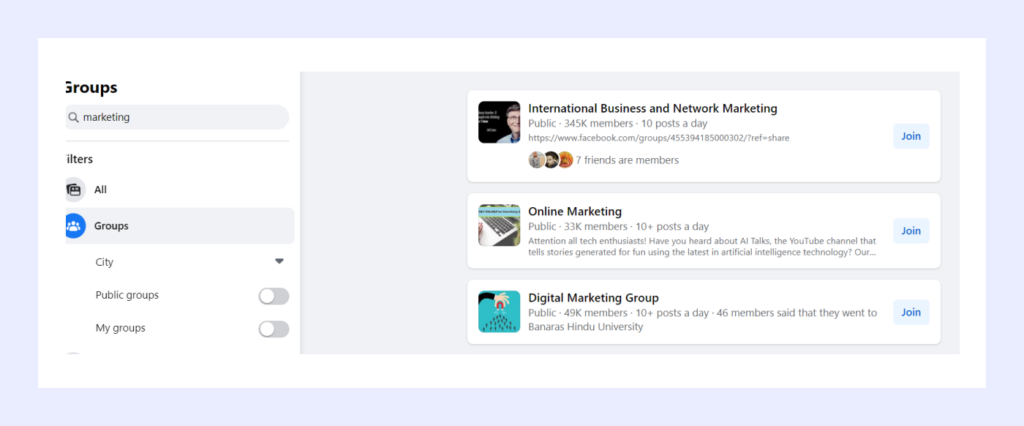
Evaluate the group’s size, engagement level, demographics and guidelines before joining it. If the group is a start, create content that provides value and positions you as an expert. You can eventually contact group members and give information about your product or service and how it will help them.
7. Webinars
With the information you have collected on your ICP, you can choose a topic about their challenges, goals, and pain points. Create a simple landing page where you drive traffic through your content, social media, email marketing or paid ads to get leads
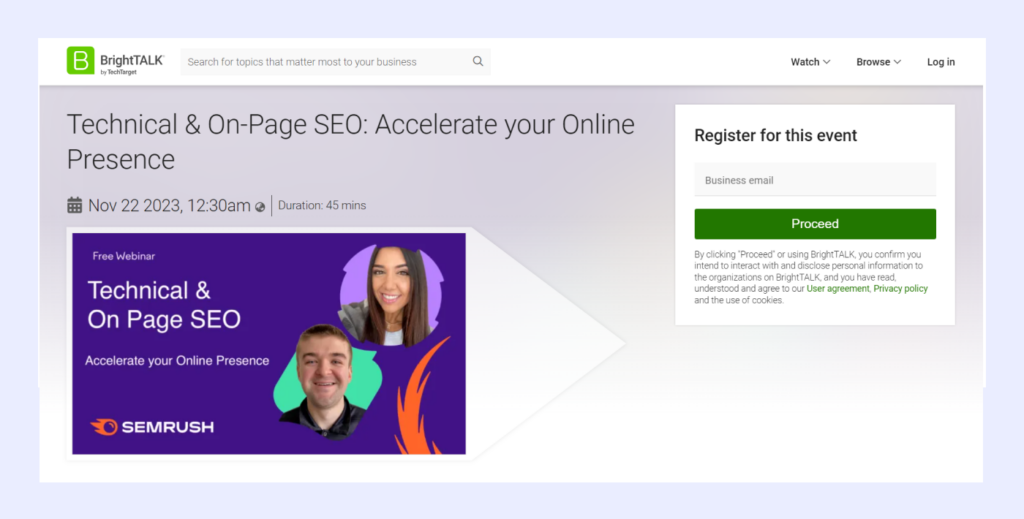
Before handing off leads to your sales team, conduct proper lead scoring to evaluate their likelihood of becoming customers.
Remember, not every webinar lead will be ready to buy after an event. In fact, many will not even attend your webinar. For this, always on-demand or replay your webinar to capture new leads. On-demand access also allows you to continue promoting the event after the live date and keep generating potential prospects.
Wrapping up
B2B prospecting has evolved over the years and doesn’t look how it used to. But there are more options than ever to accelerate your lead prospecting process. There are no defined rules for reaching more leads. You can experiment with the above mentioned methods and strategies and see which works for your sales team.
Lastly, if you want to accelerate your lead generation and don’t want to spend hours looking for them manually, try Adapt.io. It will take seconds to reach your next buyer.
